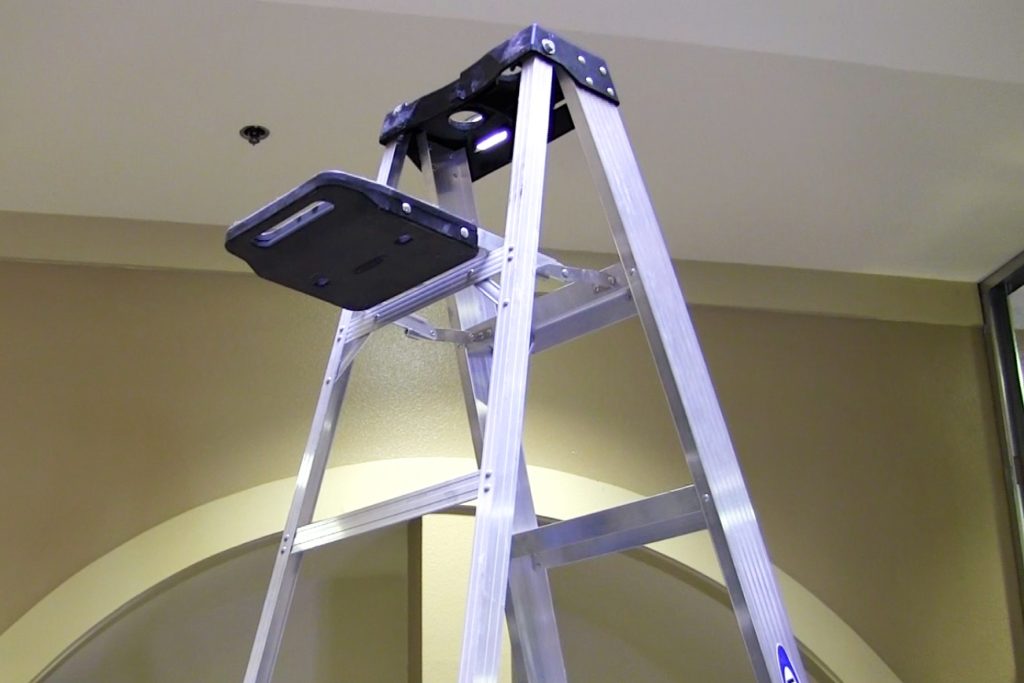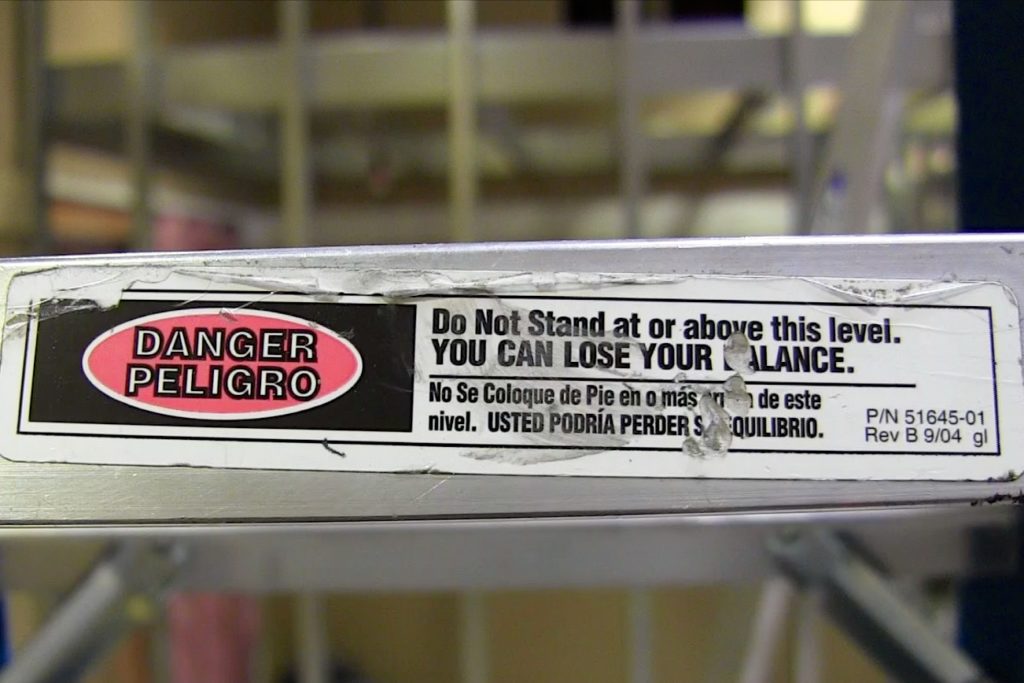
Regardless of the task at hand, when using a ladder, safety should always be the top priority. Photo: American Ratings Corporation ©2019
Every year, there are thousands of ladder-related injuries in the United States, most of which occur in non-occupational settings like residential homes. This isn’t surprising: while workers are typically trained on ladder safety, few homeowners receive such instruction, which increases the chances of improper usage. That’s why, whether you need to clean your windows, clear your gutters or access your roof, it’s important to educate yourself on ladder safety before climbing one.
In the following guide, you’ll learn:
- Ladder safety basics
- How to choose the right ladder for the application
- How to safely use extension and A-frame ladders
- How to be prepared for a fall
- The #1 way to avoid a ladder-related injury
Step one: Ladder safety basics
Before we get into the specifics of ladder safety, let’s go over some rudimentary guidelines:
- Ensure adequate height. Never use a ladder that isn’t tall enough to reach the area you’re working in. Whether you’re using an extension or A-frame ladder, standing on the uppermost rungs/steps is an unsafe practice that commonly leads to accidents.
- Ensure stable footing. Regardless of whether your ladder has two or four feet, if even one of them isn’t level, your safety will be compromised. If needed, use a piece of plywood or a similar type of shim to level out the feet. Additionally, some ladders allow you to adjust the height of each foot.
- Assess the ladder’s integrity. Regardless of what the task is, using a shoddy or unstable ladder is a bad idea. Cheaply made brackets can make a ladder wobbly even when it’s on a relatively flat surface. If you aren’t confident in your ladder’s integrity, throw it away and buy a new one—it’s just not worth the risk.
- Read the label. Pay attention to all warnings and safety instructions printed on the ladder—they were put there for a reason.

Before using a ladder, it’s always a good idea to read the printed warning labels. Photo: American Ratings Corporation ©2019
Choosing the right ladder for the application
Regardless of the task you want to accomplish, using the wrong type of ladder can greatly increase your risk of injury. For example, Mike Ross of Ross Roofing & Construction, Inc. says you should never use an A-frame ladder to access your roof. A better choice is an extension ladder, which, since it leans against the house, is less susceptible to tipping over.
Some applications require ladders with specific characteristics. For example, if you’re working around electricity, you’ll want a ladder with fiberglass rails. Unlike the metal rails found on most ladders, fiberglass rails won’t conduct electricity to the ground, which minimizes the chances of electrocution. This is just one example of how a seemingly minor ladder feature can make a big difference in terms of safety.
Usage guidelines for extension and A-frame ladders
Proper usage can vary depending on the type of ladder you’re using. Here are some usage tips for the two most common ladder types:
Extension ladder

Before climbing an extension ladder, make sure it’s leaning at a safe angle. Photo: American Ratings Corporation ©2019
When using an extension ladder, the most important principle is to create a safe angle between the ladder and the wall it’s leaning against. When a ladder is too vertical, it has an increased risk of falling backward; when it’s too horizontal, there’s an increased risk of its feet slipping out from beneath. A good way to ensure a proper ladder angle is to use the “4 to 1” rule. For every four feet of height you have to climb, the ladder’s feet should be moved one foot away from the wall.
If you don’t want to do a lot of measuring, there’s a simpler way to assess your extension ladder’s angle. Position your feet against the ladder’s feet and extend your arms forward. If you can comfortably reach the rung in front of you with your arms fully extended, the angle is correct. If the rung is outside your reach, the angle is too wide (the feet are too far from the wall); if you can reach the rung without extending your arms, the angle is too steep (the feet are too close to the wall).
If you’re using your ladder to access your roof, consider using a ladder stabilizer. When attached to one of the upper rungs, a ladder stabilizer allows the ladder to rest against the roof instead of the gutters. In addition to increasing the ladder’s stability, this helps prevent any damage to the gutters.
One final feature of an extension ladder that warrants attention is the rung locks (commonly known as the “dogs”). These are used to lock the ladder’s rungs into place when it’s extended. However, even if you don’t need to extend your ladder, it’s a good idea to make sure the rung locks are properly engaged before climbing it.
A-frame ladder (stepladder)
Since A-frame ladders are less stable than extension ladders, they’re best used for tasks at relatively low heights. Never stand on the top cap of the ladder (the “step” at the ladder’s apex); the only exception is if you’re using a podium ladder, which is a special kind of A-frame designed to allow for this. Also, while it’s relatively safe to lean forward on an A-frame ladder (assuming you aren’t standing too high), you should avoid leaning to the side when performing tasks, as this can cause the ladder to fall sideways.
One thing you don’t need to worry about with an A-frame ladder is the angle, as this is fixed. However, you do need to make sure the spreaders are fully pushed down into the locked position—otherwise, the angle won’t be right and the ladder won’t be stable. Learn more about using and caring for an A-frame ladder.
Being prepared for a fall
Even when proper precautions are taken, ladder falls can still happen, so it’s good to be mentally prepared for the possibility. Since you’ll only have a split second to react, a little advance strategizing is certainly worthwhile. Before climbing your ladder, take stock of your surroundings and determine the safest place for an emergency landing.
Also, consider how you’ll react if your ladder falls. While your first instinct might be to jump, a better strategy (if possible) is to ride the ladder down to the ground. While it might not spare you from injury, this tactic can potentially reduce the severity.
The #1 way to avoid a ladder-related injury!
There’s one final ladder safety tip we haven’t mentioned yet, and it’s the most surefire of them all. The number one way to avoid a ladder-related injury is to stay off ladders altogether. That means leaving gutter cleaning, roof maintenance and other tasks that require ladders to the professionals.
You might wince at the thought of paying someone else to do these tasks, especially if you’re a staunch DIYer. However, when you consider the costs a ladder-related injury can incur (both financially and in terms of your physical well-being), hiring a pro can be seen as an investment that not only saves you money but may even save your life.
Find a Diamond Certified service professional in your area.
One Response
Leave a Reply
You must be logged in to post a comment.

good stuff